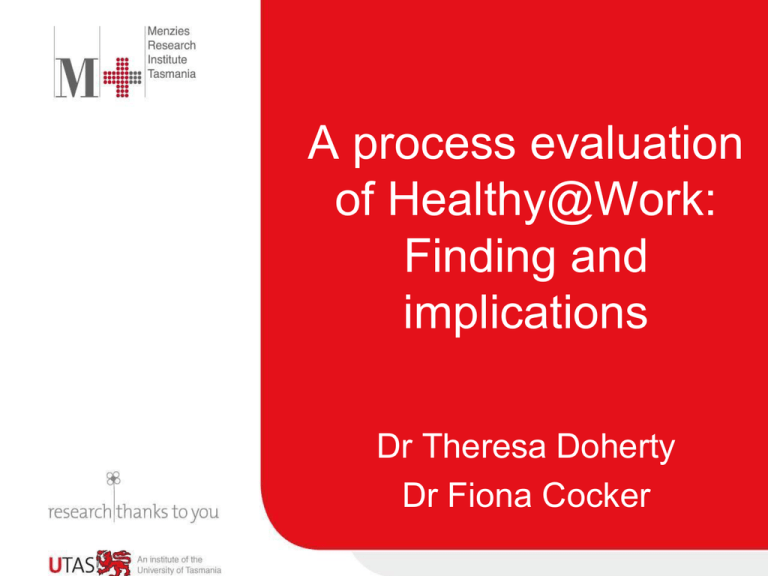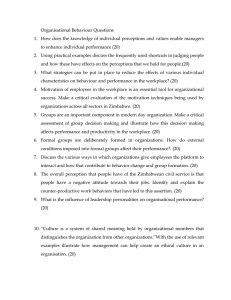Document
advertisement

A process evaluation of Healthy@Work: Finding and implications Dr Theresa Doherty Dr Fiona Cocker Seminar Aims • Present selected findings of the H@W process evaluation • Identify key themes which impact on implementation • Open discussion on implications for future workplace H&WB programs in the TSS Defining Evaluation ‘The systematic collection of information about the activities, characteristics, and/or outcomes of programs to make judgements about the program, improve program effectiveness, and/or inform decisions about future programming.’ (Patton 1997) Purpose of the Evaluation • How was Healthy@Work implemented across the Tasmanian State Service? – What happened? – What happened, in what circumstances which led to particular outcomes? – In light of these findings, would we implement a workplace H&WB program differently? Process Evaluation Methodology 1. Reviewed and analysed H@W files – the ‘formal’ story 2. Interviewed key informants – ‘informal’ story 3. Synthesised these data – deeper understanding of H@W 4. Report and disseminate the findings H@W Healthy@Work was a four-year program (2008-2012) to support the implementation of workplace health and wellbeing programs throughout the TSS Resources • • • • • H@W Guidelines H@W Website H@W grants program A professional development program An online survey MD23 • identify and address issues specific to the needs of the Agency and employees; • involve voluntary participation by employees; • include strategies addressing individual, organisational policy and environmental changes; • promote equity in the workplace by meeting the needs of employees irrespective of their current health status; • be coordinated within the organisation with governance and management structures in place; • be focused on prevention and proactive strategies; and • complement occupational health and safety goals, but ultimately be subordinate to the Workplace Health and Safety Act 1995. Ministerial Direction 23 Key question: How did the agencies respond to MD 23? • All agencies implemented health and wellbeing programs and complied with formal reporting requirements by completing annual audits between 2009 -2012. • MD 23 was received positively by the agencies. It was seen to confer authority and legitimise workplace H&WB programs. • A starting point – ‘kick the agency into gear’ • Review, reorganise, formalise existing H&WB activities • Plug established HWB program into a policy framework Implementing the MD23 . All agencies • • • • Coordinator position Coordination mechanism Needs assessment Evaluation and review process Evaluation and review ‘We also report to Agency exec at the end of each program .…to say that what the highlights and achievements were that we got from that program and propose the new one. We say “This is what we did with the last one, this is what we’ll be doing with the new one” and get their engagement and support for the types of activities we’re proposing, moving forward.’ Promoting H@W Key question: How did agencies promote H@W to their employees? • Existing internal communications methods to promote H&WB. These include the intranet, e. newsletters, emails and some set up specific H&WB intranet pages /mailboxes • FIVE organisations had set up a brand specifically for H&WB separate from HR or OH&S. H@WB programs Key question: What sort of H&WB programs/ strategies did agencies put in place? • Mental/Psychological health, • Physical activity • Nutrition Agencies used a mixture of in-house expertise and external providers for their H&WB programs . One organisation said they had not used external providers due to ‘executive caution’ in a time of financial constraints Management engagement Key question: How did Head of Agency engage with H@W? • Little difficulty in gaining senior management support • HofA /CEO were generally already ‘on board’. • Support was demonstrated in different ways • H&WB on the executive agenda • Commits resources for HWB • Actively participates in H&WB programs Management Engagement Examples of Senior Management Engagement 2010 (14 Agencies, Authorities) 2011 (14 Agencies, Authorities) 2012 (19 Agencies, Authorities) Executive Group reviews and approves proposals for H&WB initiatives Approves allocation of resources for Agency Approved & participate in the program Are very supportive of health & wellness in the workplace Fully endorse & participate in program Allow the program to be conducted in work time Encourage all staff to get involved Committed to having a budget for H&WB initiatives Provision of information, resource allocation and reporting on progress Developed the framework Oversee program content Have a key role in supporting staff to actively engage in H&WB activities Funding support for various programs Access to programs Key question: Was there equitable access H&WB programs? • • • • • • shift workers working in remote locations in single officer sites/ very small work groups no access to computers itinerant workers specific occupational groups with a negative ‘culture’. Employee engagement Key Question: Did employees engage in H&WB activities? • varying degrees ‘hardly at all’ to ‘really good’ • Estimate engagement numerically- 10%, 30% or 50% without formally measuring Two common themes emerged • the already engaged participated in workplace H&WB • The people who ‘needed it most’ did not participate Engagement • ‘There were lots of worried well who engaged but they are the fit and healthy people who simply used H@W as an extension of what they were already doing’ Key Informant Interview • ‘The ones who are interested and were previously interested in their own H&WB were really involved. The ones we’d like to target, we made no difference to at all’ Key Informant Interview Sustainability Key Questions; • Do agencies have formal H&WB policy? • Has agency continued to resource H@WB programs/ positions? • Has agency workplace culture changed? Sustainability • Audit data showed a steady increase in the allocation of resources, both time and money, to H&WB from 2009-2012. • All agencies continue to fund a H&WB coordinator position • Only three organisations identified H&WB as a specific budget item. Others funded H&WB activities out of H@W grants, from HR or OH&S allocations or from ’retained ’ program funds • Most organisations have a H@WB plan but not all are current. • Key informants did not believe H@W had resulted in any major workplace cultural shifts but most reported increased awareness of H&WB and increased openness and discussion about H&WB in the workplace. agency H&WB profile Key question: Has agency Health profile changed? • Can’t yet answer this yet. • Analysis of the Menzies H&WB 2013 survey underway Themes Workplace HWB programs only engage the already engaged 8 Workplace H&S compliance overshadows workplace HWB Structured training important but networks provide ongoing support 7 Workforce is heterogeneous and geographically dispersed 5 Organisation identifies as 'small' 5 HWB brand is a communication strategy 5 Central H@W support prematurely withdrawn 5 Economic argument an important driver 5 Politics of investing in public sector workplace HWB 3 6 Implications for H&WB in the TSS • • • • • • Size counts +ve and –ve Workplace or organisation Politics matter Competing priorities Informal networks are important Support/training needs are ongoing








